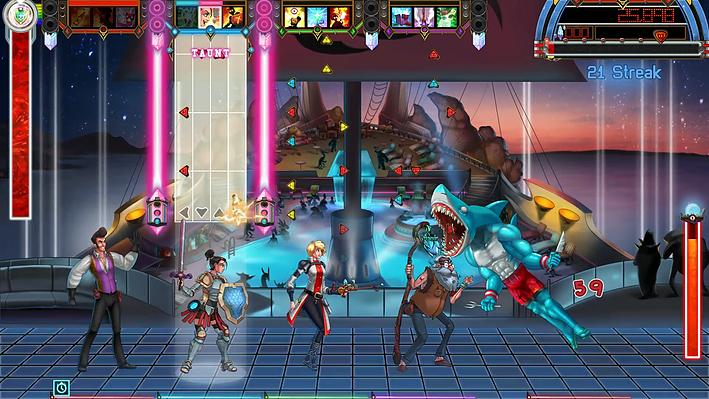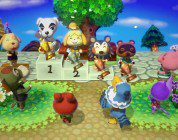Puuba’s The Metronomicon is a fascinating little conundrum. While it is a dancing game, it is also a role playing game. They go hand in hand, and they each play off of each other. While yes, it is a rhythm game, it does have its own story mode, much in the sense of an RPG. It is an interesting mashup, but the important question is: Does it work? And the answer is yes, yes it does.
In The Metronomicon, you follow four students of the rhythmic combat arts, in their adventure just after graduation in stopping Monsters from partying and ruining our world. By holding raves, they are disturbing residents, and creating turmoil to the inhabitants of the planet. On your journey, you will meet four more fighters of the rhythmic combat arts, who will join you in your quest to Fight with the Melody.
Each party member is unique and will have their own unique abilities and traits. Our four main heroes represent the Tank, Guardian, Healer, and Mage subclasses. As you progress through the title, they will level up, get stronger, get stronger abilities and even level up said abilities. As you progress you will meet a berserker (major damage, but with setbacks), a thief (perfect for farming for items and jewels), a druid (adds buffs to aid in your battles) and….well… whatever you want to call Sara. She is a scientist who can heal, but also do some major damage. You can consider her a paladin, I guess. You can use any four of these heroes together during your adventures, with the ability to switch freely between songs.
The character building screen. Here you can rearrange your party, add equipment, and customize spells.
Now that you’ve met the party, let’s move on to features. Each of the characters can use up to three spells in a song. Depending on how long your streak is, a different spell will activate, in tiers. To use a spell, simply switch off of the track you are currently on once you complete a tier. It is a simple concept that can be difficult to use effectively. Each member can also hold up to two pieces of equipment, which can affect how much health/attack/defense they have or affect how they use spells or are affected by spells.
The game play is (relatively) simple. There are four tracks of “dance notes” coming down the highway. Each highway corresponds with a different party member. On the left side of the screen is your health, which depletes as notes are missed, and as enemies attack you. On the right hand side is the enemy you are facing. Take too long, and backup will show up. Each enemy has an attack trait they are weak against. The goal is to bounce between players to stay alive, and effectively attack the enemies until you get the boss of the song. The boss is stronger and will have significantly more health. Defeat him to get full credit for the song. That is pretty much it! So now how does the story mode work?
The story of the game is simple. If you look above, that is about as much as you need to know. In between each Dungeon of the game (which will have 10 songs), fully voiced cutscenes will give you the rundown of what is happening. While it is relatively bare compared to the depth and complexity of the game, it is simply a storytelling model that puts you in different areas of the world to stop the dancing. (almost like an anti-Footloose) While it is fun to learn the personalities of each member, like how snarky Clark the Healer is, or how big headed Pierce the Thief is, it isn’t necessary to the game; meaning, if it were to be removed, the title would miss that charm, but it wouldn’t ruin the title.
What is unique is that throughout the dungeons, certain songs will have side-quests attached to them. These side-quests will give you unique items or silver to purchase new upgrades to the home-hub. How do you do a musical side-quest? Simple, you give the song a twist. Can you build a party that will heal the most, or maybe how many enemies can you kill in the duration of the song? I found it satisfying because it is almost like a puzzle trying to find the perfect pieces that fit together to allow me to get higher on the leaderboard. While it is essentially just replaying the same song again, it gives it a different feel because of the gameplay, a unique trait that this game has due to the Rhythm RPG title.
The other main mode is Arena, which will give you a preselected team, with preselected moves to complete a song and task. It is similar to the side-quests as mentioned above, but more difficult since you don’t get to craft your own winning team. For example, the objective could be survive on a difficult song, but you are not given any healing abilities. You must use defensive abilities to marathon it through the song. While some challenges are difficult, the prizes are worth it. You can get unique items, or more silver which can be used to eventually unlock characters’ ultimate equipment. It was a refreshing break from working on my own team.
The visual style of The Metronomicon is a little off-putting at first, I will admit. However, it quickly grew onto me, and I couldn’t wait to see what type of monster would be staring me down next. For being a game about monster raves, Puuba nailed the color scheme on the head. At times dark, but generally very colorful and unique. While we are on the topic of coloring, the notes for the track can be altered. I prefer to play in the classic DDR style, where the color correlates to what beat the note is on, but there are also lane colorings, colorings to match Guitar Hero guitars (that’s right, that is supported too) and more. It excites me to see how much accessibility they are giving to rhythm gamers depending on where they come from.
Of course being a Role Playing Game, an important question is why would I repeat previous songs? As you progress, the enemies get more difficult. In the higher dungeons, it gets really difficult. I found myself backtracking to playing older songs to try to level up my abilities and my characters so I stood a chance. Which is where Pierce the Thief comes into play, and honestly why he is possibly the most useful character. His abilities will allow you to increase the chances of getting an item to drop, or to have crystals drop which will level up your abilities depending on their typing. It became a side game of “How many times can I get Pierce to activate his ability ‘Mug’ before the song ends.” The Metronomicon honestly gives you the tools to play the game however you wish, which I like. There is no “one perfect team” rather multiple teams that are perfect for situations. It is pretty refreshing as a rhythm gamer.
Finally, the most important part of the rhythm game-class: the songs. Each song is unique, and there is a wide variety of songs to choose from. There are 50 from over 40 artists. You can bounce between a funky tune, to a headbanging rock riff, to a rave inducing EDM anthem. Now, just because there is variety doesn’t mean you will want to play every song multiple times. There are some songs that are better than others, but that is the case with all music games. Most tracks left me nodding my head to the rhythm while playing, which is difficult to do during some songs because of the concentration needed.
It seems like it has became my “thing” to cover music/rhythm games within this website. I am absolutely okay with it as long as I get to keep covering titles like The Metronomicon. It is unique, fun and challenging. Just because you’re great at RPG strategy doesn’t mean you’ll do great, and just because you are a dancing machine doesn’t mean you’ll do great either. You must have a good combination of the two genres to succeed in this title, which is a lot of fun. I’ve had multiple people look at me playing this and say “How in God’s name can you comprehend everything that is happening on the screen.” There is that much going on, but the game does a nice job building you up.






